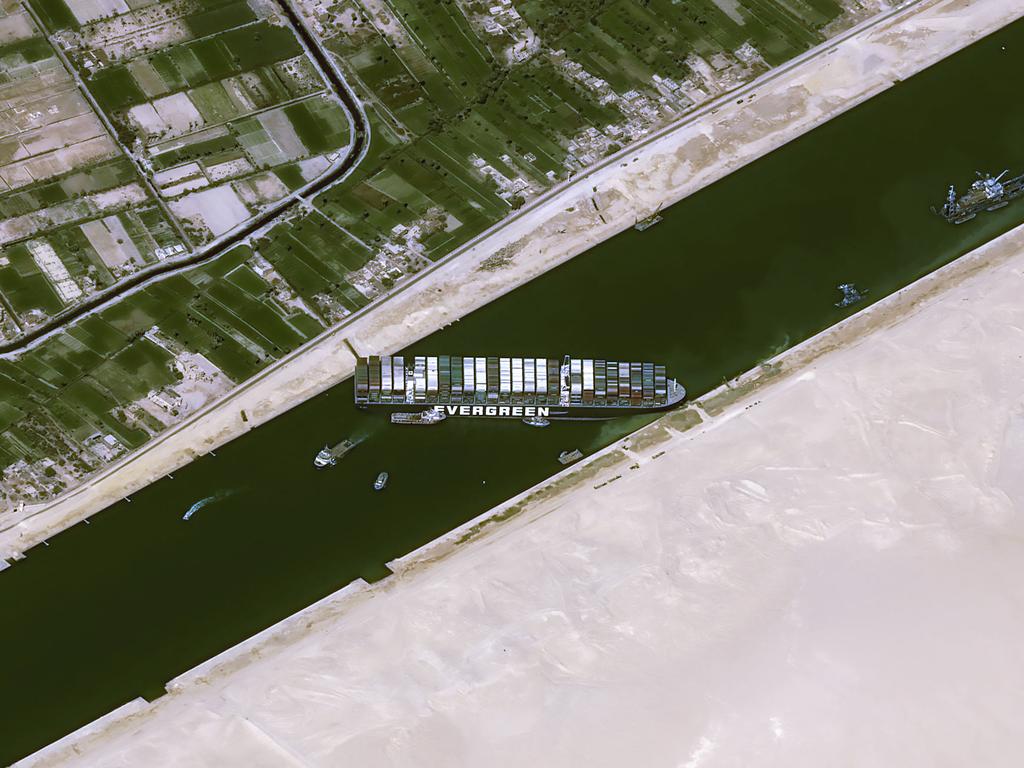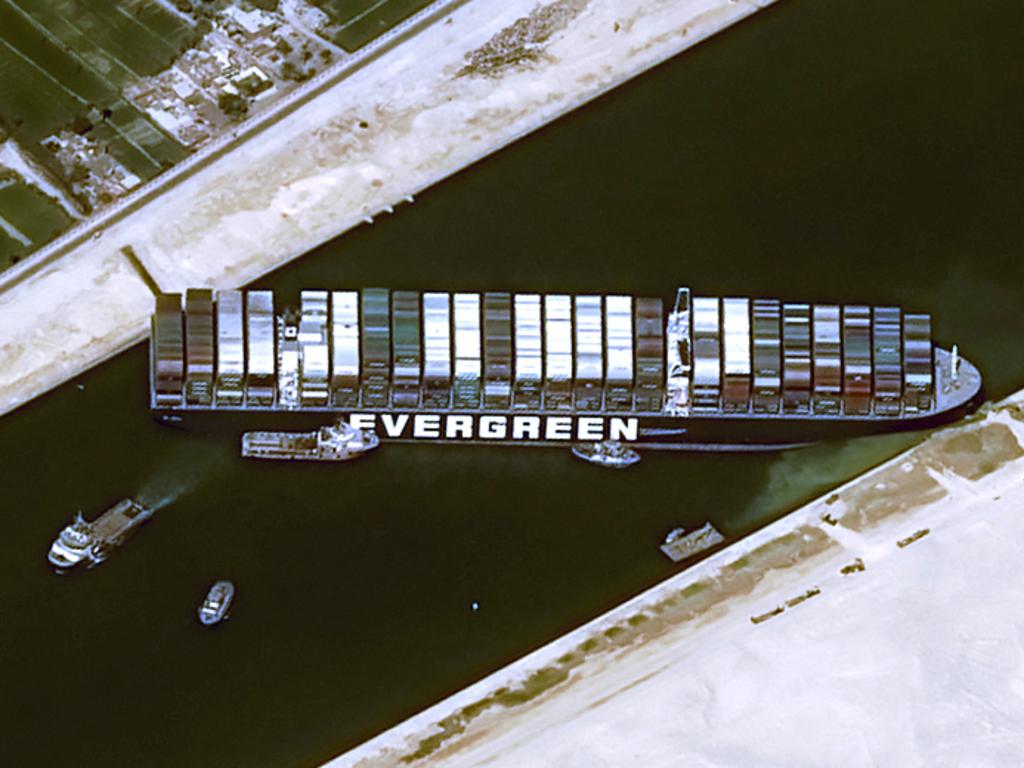Still stuck: giant ship still clogs world’s trade artery
It’s longer than four football fields, and it’s not budging. The MV Ever Given continues to confound salvage teams | WATCH

At 7.30am last Tuesday, Second Officer Ahmad Smayda, a dashing Lebanese sailor, was standing on the bridge of his vessel, looking out over the Suez Canal. Conditions were fair: visibility lay at 6 — hazy, due to a light sandstorm — and the wind was blowing at between 25 and 30 knots.
Ahead of him, ships were moving in convoy up and down the 200m wide, 24.3m deep canal, carrying hundreds of thousands of tonnes of cargo bound for ports around the world. Though Smayda didn’t know it yet, one of them was the Ever Given, a 400m long, Panama-flagged ship that was at that very moment powering northwards through the southern part of the canal at 13 knots, carrying 220,000 tonnes of cargo.
Like all other ships on the canal, the helmsman and captain of the Ever Given — and on Smayda’s ship — were being guided by advice from an Egyptian pilot.
‘There’s been an engine failure’
Then, the radio system on board Smayda’s ship crackled to life. “There’s been an engine failure,” said one of the pilots on the other ships, speaking Egyptian Arabic.
Sixty nautical miles to the south, at one of the more desolate parts of the canal — not far from where rusted skeletons of tanks from the Yom Kippur War still litter the desert – the Ever Given moved slightly to port, before veering dramatically to starboard and crashing into the canal’s thick concrete bank.
Bow in Asia, stern in Africa
When it came to a halt, the ship lay jammed across the canal: its bow in Asia, its stern in Africa, blocking the artery that 12 per cent of the world’s trade passes through on a daily basis.
Five days later, despite the best efforts of leading salvage experts, it’s still there. For every day it remains, up to $10 billion in trade could be lost.
The latest effort — featuring 14 tugs, heavy equipment, and the hope high tides would help with the job, have come to naught.
For the sailors involved, it’s nothing short of a disaster. In the Bitter Lakes, which lie halfway down the canal, about 30 ships are waiting — their crews bored, sweaty and cursing their luck. Smayda and his colleagues are among them. Below deck is cargo of livestock: 9000 sheep and 150 bulls have been sweltering in the 34C heat. By Friday, when they were supposed to have arrived in Jeddah, 45 of the sheep had died.

“You need to supply them with water, you need to supply them with fodder. We will lose everything after two or three days,” said Smayda, 33.
Experts warn that even in a best-case scenario, the Ever Given could take more than another week to salvage – at a cost of untold millions. Nicholas Sloane, the salvage master who led the effort to refloat the Costa Concordia after it sank off Tuscany in 2012, said the Ever Given had ploughed herself so far into sandbanks that it had created a new seabed profile. To move her, he said, experts would now be looking at how safe it would be to pump off ballast water or fuel before attempting to refloat her.
Struggle to refloat
“They’ve got to dredge away all that sandbank, metres and metres, maybe four to five metres around the bow and the stern, to allow her to refloat,” he said. “That’s the quickest option. And it gets worse from there. Basically they can pump out ballast water and they can take off fuel if the strength of the ship allows, and then the best way is to actually dredge around her and recreate a pool around her to go into a floating condition again.
But that’s not a couple of days’ work, that’s weeks.”

Then there was the worst-case scenario. Should there be structural damage to the ship, and it began sagging in the middle, it might not refloat, Sloane said. At that point, salvaging experts would have to start removing the cargo.
“There are only four or five ports around Europe that can actually take a ship like this alongside a port and have cranes that can reach the cargo,” he said. “So to do that in the Suez Canal from a floating barge is – yeah, this is really going to be a huge challenge. If they go into that scenario then you’re looking at many, many weeks and months.”
Was it really the wind?
While the salvaging experts work, the question remans unanswered: how could this have happened? What sequence of unfortunate events led to a ship the length of the Empire State Building, carrying enough cargo to fill Harrods three times over, to veer out of control and block one of the world’s busiest waterways, at a cost of billions of pounds?
The ship management company, Bernhard Schulte, has blamed a sudden, strong wind for blowing the Ever Given off course — a scenario some experts agree is plausible, if wildly unlucky. Yet others have poured scepticism on the claim. They question why none of the nearby ships were affected, and the likelihood that such an enormous vessel could have been buffeted off course – particularly given that the wind that day, while unusually strong, was within the limits set by the Suez authorities to allow ships to transit. A number of reports directly after the incident suggested that the ship had lost control after an engine failure – as reported by the pilot Smayda heard on the radio. That claim has been denied by Bernhard Schulte.

“I have a bit of a difficulty believing that high winds alone would be the result of this. Other vessels of her size transit the Suez Canal on a regular basis,” said Salvatore Mercogliano, an associate professor of history at Campbell University in North Carolina and former merchant mariner. “Her sister ship is in the canal just ahead of her heading southbound … The vessels in front or behind her didn’t report any issues.”
Should the ship be found to have crashed through human error, rather than through an act of nature, Mercogliano said, the shipping company could be liable for lawsuits for loss of wages, and from insurance companies.
In the world of big ships, the stakes for failure or success are enormous. And, like the vessels themselves, they are getting bigger. The Ever Given is one of the largest container ships in the world: part of a group of huge vessels that look, in the words of one maritime expert, like a block of flats turned on their side.
It was an earlier blocking of the Suez Canal that sparked this international maritime growth spurt, Mercogliano said. In 1967, on the eve of the Six Day War with Israel, the Egyptian president, Gamal Abdel Nasser, closed the canal. It would remain blocked for eight years – forcing international trade to reroute around the Cape of Good Hope, adding a hefty price tag, and serious delays, to international shipping. “What the maritime industry did was start building larger and bigger ships, these supertankers, these ultra large containers, these ultra large, crude carriers,” Mercogliano said. “So in many ways, the closure of the canal in 1967 leads you to vessels this size going through the canal today (Sunday) with the potential to close it again.”

After the canal was reopened by President Anwar Sadat in 1975, sailors would sometimes have to lean on the ship’s horn when they saw camels, unaccustomed to shipping, swimming across the waterway in front of them. Since then, however, the canal has been drastically expanded – most recently in 2015 – and the land around it turned into a high- security military area. Dredging machines work almost constantly to keep it free from silt and debris.
“I wouldn’t say ships are getting too big,” said Guy Dale-Smith, research ship manager at the National Oceanography Centre, and formerly the Royal Navy’s fleet navigation officer – who has navigated an aircraft carrier down the canal. “They’re fit for purpose. If their design and operational risk assessments and the Suez Canal Authority themselves determine the ship safe to navigate down the canal, then I wouldn’t question that. There are other places in the world, other canals in the world, where ships transit through with similar or less clearance on either side or underneath the keel relative to the size of the ship.”
Though the canal might be wide enough, and deep enough, for the ships to pass through – taking a 200,000-tonne vessel down the Suez involves enormous physical forces.
Hannah Cloke, professor of hydrology at Reading University, said it was easy to imagine huge ships operating “as if they are on rails”. In reality, she said, they are subject to the same forces as a toy boat bobbing on a pond. On the open ocean, the flow of water is dependent on the tides and the weather. But in a small shipping channel the movement of water is influenced by the ships themselves.

“This creates forces that are difficult to predict, particularly when combined with high winds and with very little margin for error,” Cloke said. “The shape of the channel can also have an impact, and shipping canals do need regular dredging and maintenance to prevent sections from silting up.”
Even as Egyptian officials work to reassure the world that the canal will soon re-open, others have given up, and put their faith in the trade route around the Cape of Good Hope, which adds at least seven days to the journey.
Among them was the Ever Greet, sister ship of the Ever Given, which was rounding the southern coast of Sri Lanka. Her owners, at least, seemed to think there was little sense in waiting for the canal to re-open. It could, presumably, be a while.
The Times
More Coverage








To join the conversation, please log in. Don't have an account? Register
Join the conversation, you are commenting as Logout